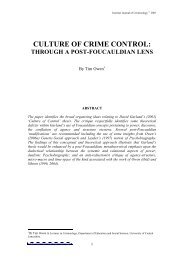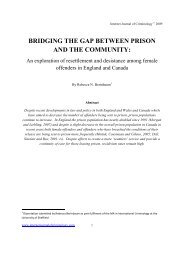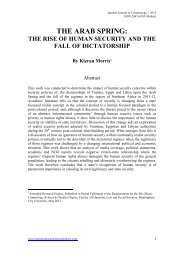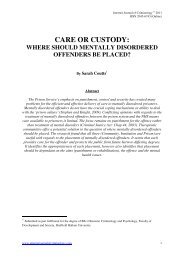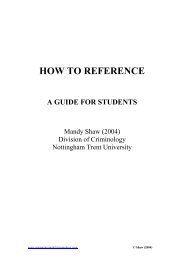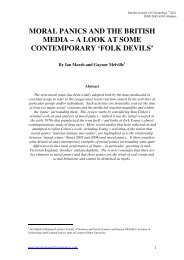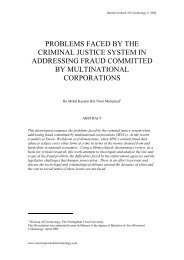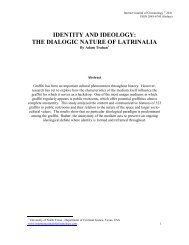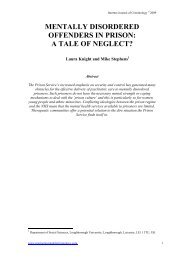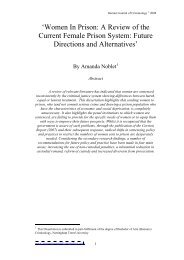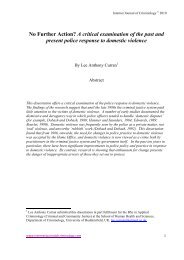four of the best - Internet Journal of Criminology
four of the best - Internet Journal of Criminology
four of the best - Internet Journal of Criminology
You also want an ePaper? Increase the reach of your titles
YUMPU automatically turns print PDFs into web optimized ePapers that Google loves.
<strong>Internet</strong> <strong>Journal</strong> <strong>of</strong> <strong>Criminology</strong> © 2011<br />
ISSN 2045-6743 (Online)<br />
FOUR OF THE BEST:<br />
A REVIEW OF FOUR INDISPENSABLE TEXTS<br />
FOR CRIMINOLOGY UNDERGRADUATES<br />
By Cathy Phillips 1<br />
So, you are newly arrived at university; you have a wok and a pasta machine (which you will<br />
never use); some new friends; lots <strong>of</strong> beer tokens in <strong>the</strong> form <strong>of</strong> a student loan, and a huge<br />
reading list. What to buy? Do you need to buy anything from <strong>the</strong> reading list?<br />
First <strong>of</strong> all, make full use <strong>of</strong> <strong>the</strong> library, and particularly <strong>the</strong> on-line services where you have<br />
access to vast number <strong>of</strong> journal articles. Get your head around <strong>the</strong> e-search tools early on,<br />
your perseverance will be richly rewarded. Use Google scholar, not only can you access<br />
journal articles, but you can also view several pages <strong>of</strong> books without having to move from<br />
<strong>the</strong> s<strong>of</strong>a.<br />
Despite <strong>the</strong> above advice, you will actually have to buy some books. You will find that most<br />
book retailers will swap your beer tokens for <strong>the</strong>m, so get <strong>the</strong>m early on before <strong>the</strong> tokens run<br />
out at <strong>the</strong> end <strong>of</strong> term 1.<br />
I have just completed my criminology degree at Nottingham Trent University and I thought it<br />
would be useful for new students to give an indication <strong>of</strong> at least some <strong>of</strong> <strong>the</strong> books that have<br />
been essential over <strong>the</strong> last three years. What follows is a personal and decidedly uncritical<br />
view <strong>of</strong> some <strong>of</strong> <strong>the</strong> books that have been so useful that I would recommend you buy your<br />
own personal copy <strong>of</strong> each. I used <strong>the</strong>m all for every single essay I wrote and for every<br />
module I studied; if <strong>the</strong>y weren’t actually used in <strong>the</strong> text <strong>of</strong> an essay, <strong>the</strong>y were vital as<br />
background reading in getting to grips with a subject.<br />
<strong>Criminology</strong><br />
Tim Newburn: Willan Publishing 2007<br />
‘One <strong>of</strong> <strong>the</strong> great things about books is sometimes <strong>the</strong>re are some fantastic pictures’<br />
(G.W.Bush, 2000)<br />
Indeed <strong>the</strong>re are some great pictures in this book; <strong>the</strong>re are also lots <strong>of</strong> tables, inserts and<br />
figures, which all break up <strong>the</strong> text making it accessible and easy to read in bite sized chunks.<br />
This is <strong>the</strong> book’s strength I think in that it presents <strong>the</strong> information in a visually interesting<br />
and engaging way ideal for first year students and as informative background to a whole host<br />
<strong>of</strong> topics.<br />
The book covers an enormous amount <strong>of</strong> material divided into six broad areas:<br />
� Understanding Crime and <strong>Criminology</strong>- with separate chapters on <strong>Criminology</strong> itself;<br />
<strong>the</strong> history <strong>of</strong> crime and punishment; crime data and trends, and crime and <strong>the</strong> media.<br />
1<br />
Nottingham Trent University<br />
www.internetjournal<strong>of</strong>criminology.com 1
<strong>Internet</strong> <strong>Journal</strong> <strong>of</strong> <strong>Criminology</strong> © 2011<br />
ISSN 2045-6743 (Online)<br />
� Criminological <strong>the</strong>ory.<br />
� Types <strong>of</strong> crime- its victims; white-collar crime; organised crime; violent and property<br />
crime, and drugs and alcohol.<br />
� The criminal justice system.<br />
� Critical issues including race; gender; terrorism, and human rights.<br />
� Criminological research.<br />
This book achieves exactly what it sets out to do for <strong>the</strong> new student, covering everything<br />
that is likely to be studied at undergraduate level, giving a broad overview <strong>of</strong> <strong>the</strong> topic in<br />
question and pointing to fur<strong>the</strong>r reading and internet links. If <strong>the</strong>re is one criticism, it is that<br />
<strong>the</strong> recommended reading lists are short, but this is a deliberate ploy by <strong>the</strong> author to get<br />
students to find <strong>the</strong> material <strong>the</strong>mselves. No matter, since <strong>the</strong> book’s strength is in its<br />
introductory capacity, which is just as useful as a starting point for 3 rd year students faced<br />
with a new topic as it is for 1 st years who require an easy and interesting broad approach.<br />
The Oxford Handbook <strong>of</strong> <strong>Criminology</strong> (Fourth Edition)<br />
M. Maguire., R. Morgan., and R. Reiner. (eds): Oxford University Press 2007<br />
Sadly, no pictures in this book, but at well over 1000 pages adding pictures would make it<br />
unmanageable! This is a difficult book to read at first, not least because <strong>of</strong> <strong>the</strong> ‘academic<br />
speak’ in which most <strong>of</strong> <strong>the</strong> authors write. But persevere you must because in short, this book<br />
is <strong>the</strong> criminologist’s bible.<br />
The book’s strength lies in <strong>the</strong> depth and scope <strong>of</strong> each chapter which is written by a leading<br />
authority, and examines <strong>the</strong> relevant <strong>the</strong>ory, recent research and policy developments <strong>of</strong> each<br />
subject. The result is a comprehensive account which is vital as a follow up to <strong>the</strong> general<br />
overview given in introductory texts such as Newburn’s <strong>Criminology</strong> reviewed above.<br />
The book is divided into five parts: <strong>Criminology</strong>: History and Theory; The Social<br />
Construction <strong>of</strong> Crime and Crime Control; Dimensions <strong>of</strong> Crime; Forms <strong>of</strong> Crime, and<br />
Reactions to Crime. However, not all subjects in an undergraduate degree are covered;<br />
genocide for instance is mentioned only in passing as part <strong>of</strong> <strong>the</strong> chapters on violent crime<br />
and victims and victimisation. This may in part be because criminology is a developing<br />
discipline, and has shied away from tackling state crimes as a legitimate part <strong>of</strong> <strong>the</strong><br />
criminological agenda, recognising that existing frameworks and methodological issues may<br />
not be robust enough to deal with <strong>the</strong> complex issues involved, but such ‘marginal’ topics<br />
deserve serious consideration for future inclusion.<br />
As you begin to get to grips with this book, it may be useful to skip <strong>the</strong> mind boggling array<br />
<strong>of</strong> statistics <strong>of</strong>ten included in <strong>the</strong> first part <strong>of</strong> a chapter, o<strong>the</strong>rwise <strong>the</strong>re is a danger <strong>of</strong><br />
becoming bogged down before you have a basic understanding <strong>of</strong> <strong>the</strong> subject. You will have<br />
undoubtedly been given an idea <strong>of</strong> relevant trends in lectures, and you can always return to<br />
<strong>the</strong> figures once you actually begin to write.<br />
As you progress through your degree, you will undoubtedly find that you will use <strong>the</strong> book<br />
more <strong>of</strong>ten; <strong>the</strong> language will become less impenetrable, and you may even begin to look<br />
forward to reading such an authoritative and scholarly collection.<br />
www.internetjournal<strong>of</strong>criminology.com 2
Criminological Perspectives (Second Edition)<br />
<strong>Internet</strong> <strong>Journal</strong> <strong>of</strong> <strong>Criminology</strong> © 2011<br />
ISSN 2045-6743 (Online)<br />
E. McLaughlin., J. Muncie., and G. Hughes. (eds): Open University Press 2007<br />
This little gem <strong>of</strong> a book may not be on your reading list, but it most certainly should be.<br />
Organised into six broad areas, <strong>the</strong> book covers almost every diverse strain <strong>of</strong> criminological<br />
<strong>the</strong>ory which has contributed to <strong>the</strong> current state <strong>of</strong> criminological knowledge:<br />
� Part 1 Past Tense: Criminological formations, contains <strong>the</strong> works <strong>of</strong> Beccaria;<br />
Bonger, and Durkheim.<br />
� Part 2 The problem <strong>of</strong> crime 1: Causation, contains Murray; Felson, and Katz.<br />
� Part 3 The problem <strong>of</strong> crime 11: Criminalisation, contains Sykes and Matza; Box, and<br />
Becker.<br />
� Part 4 Crime control 1: Criminal justice and crime prevention, contains Wilson;<br />
Clarke, and Currie.<br />
� Part 5 Crime control 11: Discipline and governmentality, contains Feely and Simon;<br />
Garland, and Foucalt.<br />
� Part 6 Future Tense: Criminological transformations, contains Smart; Cohen, and<br />
Ferrell.<br />
The beauty <strong>of</strong> this book lies in <strong>the</strong> fact that such a diverse spectrum <strong>of</strong> criminological thought<br />
is represented, and in <strong>the</strong> fact that <strong>the</strong> book reproduces <strong>the</strong> original works <strong>of</strong> <strong>the</strong> pioneers,<br />
ra<strong>the</strong>r than ano<strong>the</strong>r academic’s explanation <strong>of</strong> <strong>the</strong>ir contribution. For example, <strong>the</strong> work <strong>of</strong><br />
Enrico Ferri- a disciple <strong>of</strong> Lombroso, may easily be dismissed nowadays as racist or sexist,<br />
but actually reading <strong>the</strong> text, which is reproduced in Part 1, leads to a greater understanding<br />
<strong>of</strong> how this school <strong>of</strong> thought evolved and developed, and highlights how positivist thought<br />
began to examine <strong>the</strong> idea <strong>of</strong> how <strong>of</strong> social justice might interact with biological factors in<br />
causing crime.<br />
The arrangement <strong>of</strong> <strong>the</strong> texts shows quite clearly how some schools <strong>of</strong> thought ‘conversed’<br />
with each o<strong>the</strong>r and thus how criminology has developed over time. In addition, <strong>the</strong> inclusion<br />
<strong>of</strong> <strong>the</strong> original references shows in turn, how <strong>the</strong>se pioneers have developed <strong>the</strong>ir own<br />
<strong>the</strong>oretical position. This is a fascinating and eclectic collection; and indeed should be<br />
‘essential’ reading for any serious student <strong>of</strong> criminology.<br />
An Introduction to Criminological Theory (Third Edition)<br />
Roger Hopkins Burke: Willan Publishing 2010<br />
There is an in-depth review <strong>of</strong> this book elsewhere in this journal, so this review will be brief.<br />
The book examines each <strong>the</strong>oretical tradition in a clear and easy to understand style, and also<br />
examines <strong>the</strong> political context in which <strong>the</strong>se <strong>the</strong>ories arose. You will return to this book<br />
repeatedly even after you have completed your criminological <strong>the</strong>ory module. Particularly<br />
useful are <strong>the</strong> critical analyses which you will skim over in Year 1, but which will be vital in<br />
Year 3. In addition, <strong>the</strong> comprehensive suggestions for fur<strong>the</strong>r reading will be valuable when<br />
searching for o<strong>the</strong>r viewpoints. Therefore, this book has hidden depths and should not be<br />
regarded as an ‘introductory’ text alone.<br />
www.internetjournal<strong>of</strong>criminology.com 3
<strong>Internet</strong> <strong>Journal</strong> <strong>of</strong> <strong>Criminology</strong> © 2011<br />
ISSN 2045-6743 (Online)<br />
Each book will be useful as background and general reading in Year 1, but in Years 2 and 3, I<br />
approached each module/essay/exam in exactly <strong>the</strong> same way:<br />
� Read <strong>the</strong> chapter in Newburn’s book<br />
� Read <strong>the</strong> corresponding chapter in <strong>the</strong> OHC<br />
� Find out how it all began in Criminological Perspectives<br />
� Revisit <strong>the</strong> <strong>the</strong>oretical and relevant political context in Criminological Theory<br />
Good luck.<br />
www.internetjournal<strong>of</strong>criminology.com 4




